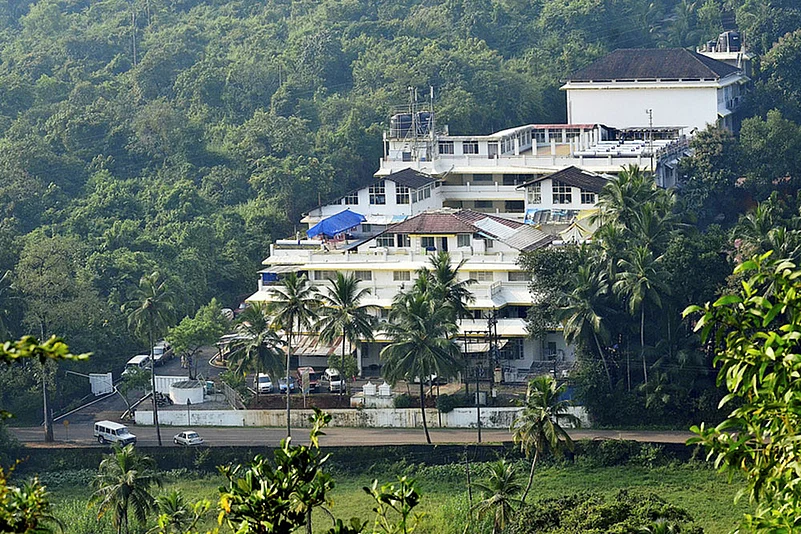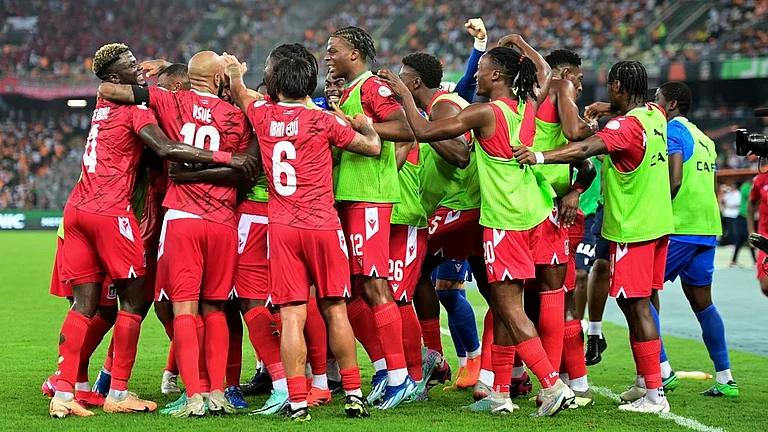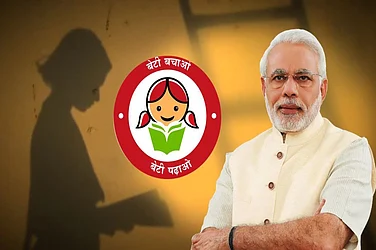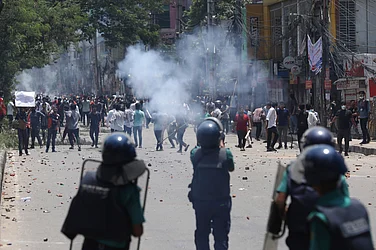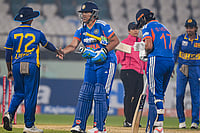2008: Two low-intensity blasts at theatres in Thane and Vashi, ostensibly to protest against a satirical play, cause a temporary stir about the possible involvement of a right-wing organisation.
2008: A bomb is found in Cineraj Theatre in Panvel that was screening Jodha Akbar
2009: Two people die while transporting a bomb in Madgaon, Goa.
2011: Sheetal Chinchkar leaves her Baramati home on March 3, 2011, to stay at an ashram. (She has refused to return since then. At the age of 23, Sheetal, the eldest of three sisters, had a job in a good bank, loving parents and a modest life. She was also the typical well-behaved, dutiful sister and daughter that made her mother Shobha hope and dream of better days for their family. Her father Baburao runs a bakery and Shobha runs a tiffin service. Neither had any idea that they were allowing their daughter to set out on a ‘spiritual path’ of no return. Last week her mother wished her on her 29th birthday and pleaded with her yet again to return. She refused politely. Her family feels she has been hypnotised.)
2011: An exasperated Vijay Rokade, whose wife chose ishwar seva over marital life in 2007, joins hands with three other families, including the Chinchkars, to file a PIL in the Bombay High Court requesting the court to probe the activities of the organisation and also ban it in national interest.
2013: Rationalist Narendra Dabholkar is shot dead in Pune .
2015: Govind Pansare, CPI leader and author of a Marathi biography of 17th-century ruler Shivaji, Shivaji Kon Hota (Who was Shivaji?), dies four days after being shot.
The common thread running through these seemingly unrelated facts is the organisation known by the name Sanatan Sanstha. The “scientific, spiritual” outfit, founded in the 1990s (1999 as per the official website) and perhaps not taken seriously for years, now makes it to the news repeatedly due to the alleged involvement of its members in acts of terror and the cold-blooded murders of Dabholkar and Pansare.
“I used to supply packed meals to some women from Sanatan Sanstha,” recalls Shobha Chinchkar, mother of Sheetal. “That’s how they started interacting with my daughter. I thought it was related to godly matters, so I didn’t object when they asked if Sheetal could accompany them. Slowly she became too involved and started bunking work. She also turned down several marriage proposals. When I complained to the main person in this centre about her irregular behaviour at the bank, they started meeting her without informing us. One day she said she was going to work and never returned.”
Shobha goes on to narrate how they went to meet their daughter and bring her back, but were allowed to speak to her only for a few minutes and that too not in private. “She insists she wants to do ishwar seva and won’t return. I can’t bear to see and hear her like that,” the mother tells Outlook over the phone from Baramati, unable to stop sobbing. “Sheetal used to do naamjap (a kind of chanting) with the names of her parents written on chits, hoping that prayers would make them come around.”
The PIL filed in the Bombay High Court details four such cases. Sanatan Sanstha has denied all allegations (see interview). The petition was filed in 2011, four years after Rokade’s wife left him, and the marriage was declared null and void in 2014. He tried to find out what could have led to his wife’s departure and came across psychiatric concepts such as Ericksonian Hypnosis (also known as “covert” or “conversational hypnosis”, which allows the subject to accept only suggestions they are comfortable with, at their own pace, aware of the benefits of their transformation and participating in it). He believes such methods were used to alter his then wife’s state of mind. The petition says women like Sheetal can be used for terror activities.
“No one really took them seriously a first. They were seen as a bunch of mad people. But as we investigated the Thane blasts, we were able to prove the role of the members,” says a former ATS officer. Two accused were convicted, but the role of the organisation could not be established.

An illustrated chart on ‘military training’, Sanstha-style
One organisation, however, followed the Sanstha closely for what it advocated and practised. Dabholkar’s Andhashraddha Nirmoolan Samiti (ANIS), which works to promote scientific temper and eradicate superstitious practices and beliefs, stood in sharp contrast to the path of ‘moksha’ that the Sanstha laid out. ANIS had also taken up a few cases of families whose girls had refused to come back. Rahul Thorat of ANIS says, “The way they work is quite clever. They speak a different language, using phrases like ‘durjan ka vinash’ and establishing ‘ishwari rajya’. They would file counter-cases if you tried to oppose their activities. They had Dabholkar’s picture with a red mark on their website before his murder.” Sanatan Sanstha member Virendra Tawde’s arrest in the case points to a role of the organisation, claim the investigating agencies, but that is yet to be proved in a court of law.
The websites of the Sanstha and the Hindu Janajagruti Samiti (HJS), an allied outfit, use their websites to preach about the “establishment of the Hindu Rashtra”. Their reports and articles have been compared to those published by Shiv Sena mouthpiece Saamna and considered just as provocative. From suggesting that Hindus should become “like Naxals to save the religion” (with a photo of Jayant Athawale in a military outfit) to speaking about Dabholkar’s death in karmic terms, the publication doesn’t try to be politically correct and shows little regard for facts. The website also provides “scientific explanations” for religious beliefs and there is a whole section on how gopis worship Krishna. Sanstha members believe their leader Athawale is like Krishna, claim activists critical of the organisation.
The terror connect apart, the PIL gives a glimpse into some quirky aspects of the Sanstha’s beliefs. In its scheme of things, propagated in texts such as Naamjapache Fayde, there are various levels of spiritual attainment (going up to “sainthood”), and, while the “personal sadhana” is about removing “negative qualities” from the self (including sexual desire), there is also sadhana for the society—the next level—that calls for sacrifices to “protect the dharma”.

Story on Dabholkar murder case in Outlook (July 14, 2014)
As early as 2011, Father Joseph Dias of the Catholic Secular Forum had pointed out that the Sanstha was among some right-wing organisations whose members were being given arms training. A picture from the “training manual”, with instructions on the use of weapons, was in circulation. “There is enough evidence of arms training being given by Hindutva outfits such as Sanatan Sanstha and HJS, making it a fit case for banning them,” says Dias. “If SIMI could be banned why not these two?”
Though former home secretaries Amitabh Rajan and Umesh Sarangi agree that the report was thorough and strongly recommended the ban, the report is still awaiting implementation. It is currently pending with the central government.
The Sanstha admits they use hypnosis for “positive benefits”. Psychiatrists fear the method could as well be used by cults for indoctrinating their members. “Mass hypnosis for collective indoctrination is successful in a milieu where charismatic leaders tap into the psyche of a population that regresses and rebels, seeking shelter in narratives that are medieval and barbaric,” says psychiatrist Dr Harish Shetty. “One cannot hypnotise those who don’t want to be hynotised, but a loyal flock can always be indoctrinated and suggestions implanted in their minds. I know of spouses leaving their partners, but most of them have had issues in life and are psychologically vulnerable. This is also true for other sects that are secretive and violent.” Shetty believes that an ideological debate is more important than banning such outfits.
On the Sanstha’s ideology, Communalism Combat editor Teesta Setalvad says, “The FIRs, chargesheets and their literature (a book titled Dharm, for instance) indicate a dangerously supremacist worldview, and an organisation that uses violence and other questionable techniques. Writings coming from their Panvel ashram and probes into their activities hint that they incite and train a body of followers, who are ready for actions that violate the law and the Constitution.”

Special public prosecutor Rohini Salian, who quit the Malegaon case after disclosing that NIA had asked her to go soft in the prosecution of Abhinav Bharat members, was also the prosecutor in some of the Sanstha cases. She says they were able to prove the role of two accused but nothing more. “My impression was they were fanatics. They didn’t know what they were doing with all those childish kits. It looked very stupid. Though they were staying at the Panvel ashram of the Sanstha, we could not get evidence connecting the organisation. We only tried those who participated in the three blasts.”
In fact, for a long time, even as the probes were pointing at the involvement of Hindutva terror outfits in various incidents, the Sanstha wasn’t considered a threat. “Had the isolated incidents been probed as an organisational conspiracy, perhaps the last couple of incidents could have been avoided,” says the slain Govind Pansare’s daughter Megha.
As ATS chief, Hemant Karkare had led the Abhinav Bharat probe until his death during the 26/11 Mumbai attacks. His investigations led to cases against Sadhvi Pragya Thakur and Colonel Purohit, among others. By 2011, the ATS had put together a dossier on the Sanstha and recommended a ban under the UAPA.
But is there any connection between these organisations? “It would be wrong to look at the Sanstha in isolation. It is one of the heads of a hydra-headed creature whose mothership is the RSS. Many organisations like them carry out activities that the RSS can disassociate itself from,” says filmmaker Rakesh Sharma. Setalvad says, “As an investigator, the key dispassionate question should be, what are their links with the Hindu Mahasabha and the Rashtriya Swayamsevak Sangh, both distinct yet linked and both visible politically (even though the latter calls itself a ‘cultural’ organisation).”
Anti-communalism activists, though, are doubtful if anything concrete will happen. “The previous government made the right noises, but could not ban these outfits because of powerful Hindutva sympathisers within the ruling political parties,” says Dias. “The current government’s preferences are well known, because it has come to power with the help of these groups. Going by the way the Gujarat or other cases have gone, one can expect not only no action, but also clean chits to the accused.”
“The key problem with our law enforcement and intelligence agencies is that they are far too lenient when it comes to Hindutva outfits and their worldview, refusing to see them as dangerous and a threat to rule of law and national security. Spewing hatred at the minorities, especially Muslims, is integral to their credo.”
Systemic challenges to their prosecution is only part of the story. The other part is the acceptability they easily find in civil society. “All they need is someone who is a Hindu by birth and not in the habit of asking questions. And there is no dearth of them. That’s how a person sitting in a village in Marathwada can get excited or angry about the Ram temple in Ayodhya. They only need to be instigated through Facebook or Whatsapp,” says playwright and actor Rajkumar Tangde, whose play Shivaji Underground in Bhimnagar Mohalla was targeted by the Sanstha several times. “On the other hand, it takes years to cultivate a socialist or a communist supporter but tacit right-wing supporters, who do not necessarily engage in violence but don’t condemn it either, are all over the place.”
Refusing to give up, Tangde’s team has done more than 450 shows so far. He says, “Only if youth between the age group of 18-24 are sensitised and educated, there is some hope of returning to a secular atmosphere.” It is precisely the age group to which women like Sheetal belonged when they left home to do ishwar seva. Her mother is worried she may be used in any such crimes. “I don’t care about money, what the organisations do, what happens where. I just want my daughter back,” she says. The case will come up for hearing next week.
***

Terror Trail
- February 2008: Blast in Cineraj theatre Panvel during screening of Jodha Akbar
- May 2008: Bomb found at Vishnudas Bhave auditorium where a play titled Amhi Pachpute was to be staged
- June 2008: Blast at Gadkari Rangaytan Theatre, Thane, where the same play was being staged. Eight injured.
- October 2009: Two men die while transporting a bomb in Madgaon, Goa
- April 2011: Congress-NCP government in Maharashtra seeks ban on the Sanstha
- 30 August 2011: Ramesh Gadkari and Vikram Bhave sentenced to 10 years in the Thane blast case. They are out now. Four others were acquitted.
- September 2011: PIL in Bombay High Court seeking a ban
- August 2013: Narendra Dabholkar shot dead
- January 2014: Vinay Talekar, Dhananjay Ashtekar, Prashant Ashtekar, Vinayak Patil, Prashant Juvekar and Dilip Mazgaonkar acquitted in Madgaon blasts case
- February 2015: Govind Pansare and his wife shot. Pansare dies in four days.
- September 2015: Sanstha member Sameer Gaikwad arrested in Pansare murder case
- June 2016: HJS member Virendra Tawde arrested in Dabholkar murder case
- July 2016: Government of India tells the Bombay High Court that they need more information from the state government regarding the proposed ban. NIA has reportedly deposed saying there is insufficient evidence to impose a ban.
By Prachi Pinglay-Plumber in Mumbai






